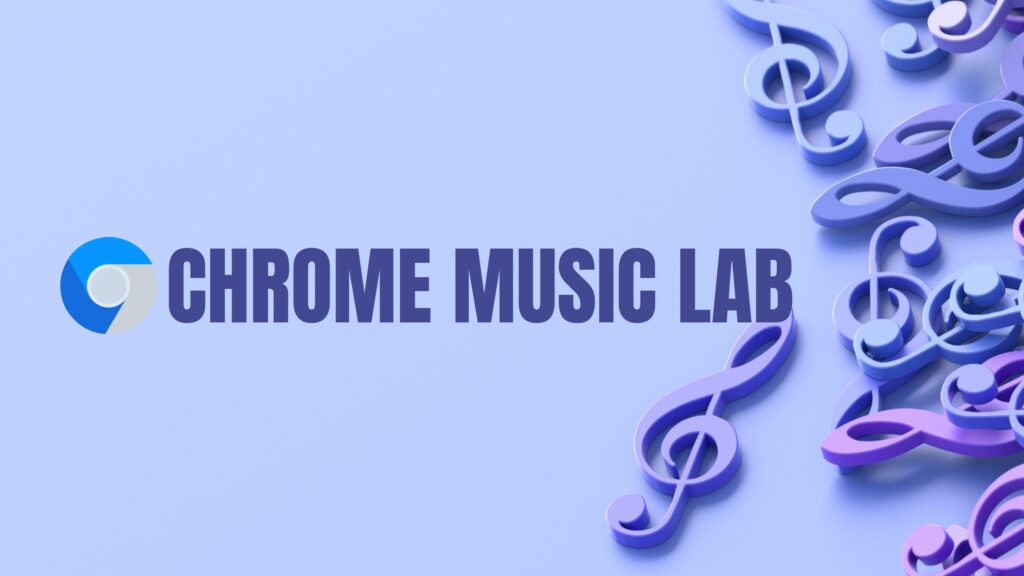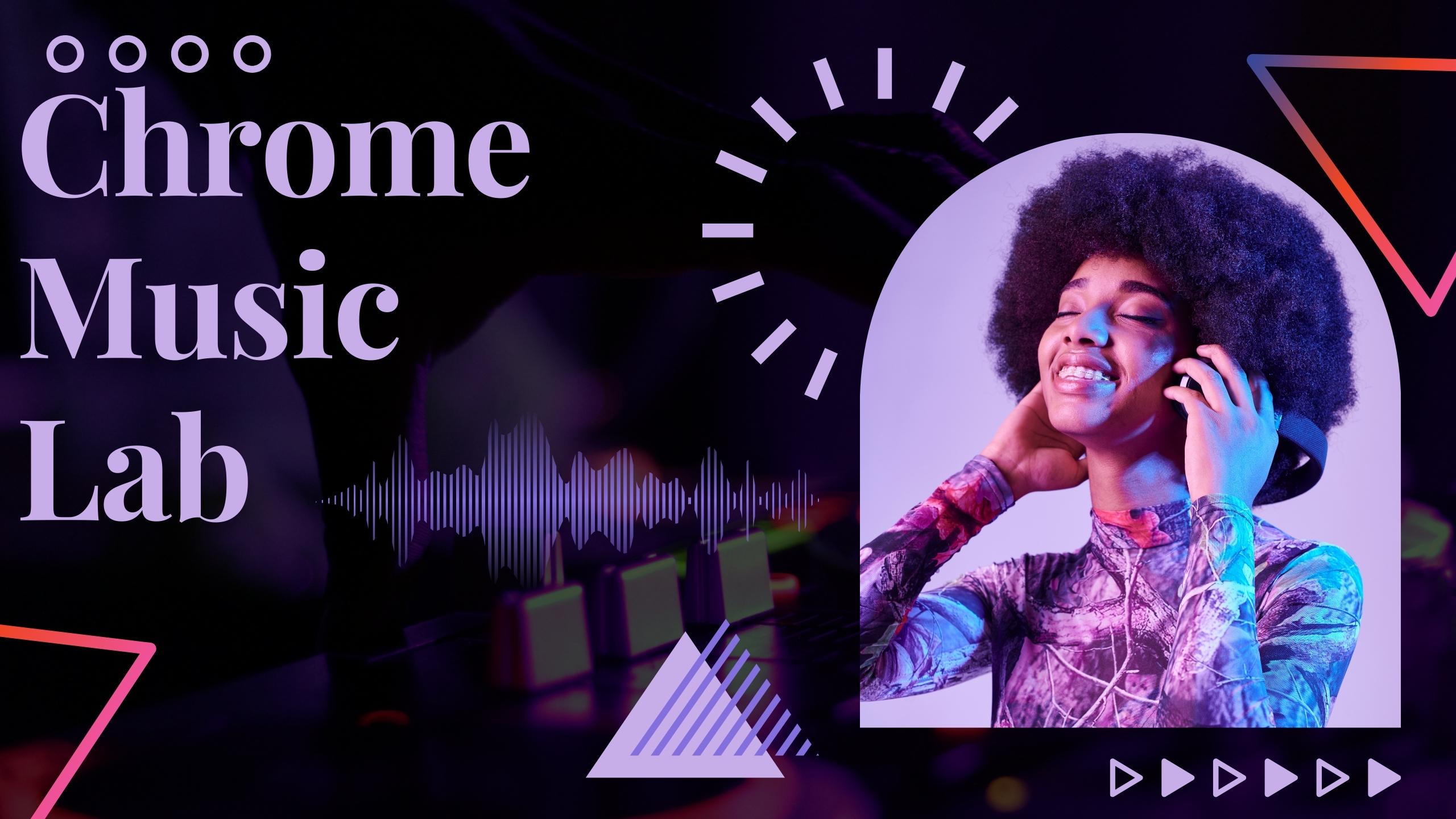Chrome Music Lab is a fantastic online resource that allows users to explore and experiment with various musical concepts and tools. It is a collection of interactive web-based music experiments and games developed by Google, designed to make music education and creation more accessible and enjoyable for people of all ages and musical backgrounds.
With Chrome Music Lab, you can delve into different areas of music theory, composition, and sound manipulation. The platform offers a range of experiments, each focusing on a specific musical concept or technique. Here are a few notable ones: Song Maker, Rhythm, Spectrogram, Oscillators, Chords, etc.
These are just a few examples of the experiments available in Chrome Music Lab. Each experiment offers a fun and interactive way to learn about music concepts and spark creativity. Additionally, Chrome Music Lab provides resources for educators, including lesson plans and activities, making it a valuable tool for music education in classrooms.
Whether you’re a music enthusiast, a student, or a teacher, Chrome Music Lab provides an engaging platform to explore, learn, and unleash your musical creativity. It’s accessible through a web browser, making it easily available to anyone with an internet connection.
What is Chrome Music Lab and How Does it Work?
Chrome Music Lab is an online platform developed by Google that offers a collection of interactive music experiments and tools. Its primary aim is to make music education and exploration accessible to people of all ages and musical backgrounds. The experiments are designed to be intuitive, engaging, and user-friendly.
Here’s how Chrome Music Lab works:
1. Access:-
Chrome Music Lab can be accessed through any web browser on a computer, smartphone, or tablet. Simply visit the Chrome Music Lab website to start exploring the various experiments.
2. Experiments:-
Once you’re on the Chrome Music Lab website, you’ll find a range of different experiments available to choose from. Each experiment focuses on a specific musical concept or technique.
3. Interactivity:-
The experiments are designed to be interactive, allowing you to manipulate different parameters and elements to create and explore music. Depending on the experiment, you may have options to adjust tempo, choose instruments, create melodies or rhythms, modify sound parameters, and more.
4. User Interface:-
The user interface for each experiment is designed to be intuitive and visually appealing. It often includes elements like grids, sliders, virtual keyboards, and buttons that you can interact with using your mouse, touchpad, or touchscreen.
5. Sound Output:-
As you interact with the experiments, they generate sound output in real-time. You can listen to the sounds you create, experiment with different combinations and settings, and make adjustments to refine your musical ideas.
6. Learning Resources:-
Chrome Music Lab provides additional resources to enhance the learning experience. These may include interactive tutorials, explanations of musical concepts, and lesson plans for educators. These resources help users understand the underlying principles behind the experiments and encourage further exploration.
7. Collaboration and Sharing:-
Chrome Music Lab allows you to collaborate and share your creations. You can save and share links to your compositions, allowing others to listen to and even remix your work.
Whether you’re a beginner exploring music for the first time or an experienced musician looking for a creative outlet, Chrome Music Lab offers an accessible and enjoyable way to experiment with music. Its interactive nature and diverse range of experiments make it a valuable resource for learning, creativity, and musical exploration.
Discovering the Different Experiments
Chrome Music Lab offers a variety of experiments, each focusing on a specific aspect of music. Here are some of the notable experiments you can explore:
1. Song Maker:-
Song Maker lets you create melodies and rhythms using a simple grid-based interface. You can select different instruments, adjust the tempo, and create loops to build your composition. It’s a great starting point for composing your own music.
2. Rhythm:-
This experiment allows you to explore and create different rhythmic patterns. You can select different sounds and adjust their durations to experiment with syncopation, polyrhythms, and more. Layer multiple rhythms together to create complex rhythmic textures.
3. Spectrogram:-
The Spectrogram experiment visualizes sound in real-time, displaying its frequency and amplitude characteristics. You can use it to analyze different sounds, voices, or musical instruments and observe how their frequency content changes over time.
4. Oscillators:-
This experiment introduces you to the basics of sound synthesis. You can manipulate different waveforms (such as sine, square, or sawtooth waves) by adjusting parameters like frequency, amplitude, and envelope. This experiment allows you to create unique sounds and explore the fundamentals of synthesis.
5. Chords:-
Chords lets you experiment with different chord progressions and voicings. You can play chords using a virtual piano keyboard and explore the emotional effects created by different chord combinations. It’s a great tool to learn about harmony and chord structures.
6. Harmonics:-
This experiment focuses on the harmonic series and the relationships between different pitches. You can explore the fundamental frequency and its overtones, listen to different harmonic sounds, and visualize the harmonic content of various waveforms.
7. Kandinsky:-
Inspired by the abstract artist Wassily Kandinsky, this experiment allows you to create visual art that corresponds to music. You can create shapes, lines, and colors that respond to the sounds you generate, resulting in a unique audio-visual experience.
8. Arpeggios:-
Arpeggios lets you play arpeggiated chords using different instruments and adjust parameters like speed and arpeggio pattern. It’s a fun experiment to explore melodic patterns and create rhythmic variations.
9. Melody Maker:-
This experiment focuses on creating melodies using a virtual keyboard. You can experiment with different scales and modes, adjust the tempo, and play around with rhythm and note durations to create catchy melodies.
These are just a few examples of the experiments available in Music Lab. Each experiment offers a unique and interactive way to explore different musical concepts and techniques. Feel free to dive into the Chrome Music Lab website and discover more experiments to unleash your musical creativity!

How Chrome Music Lab Can Be Used for Learning Music Concepts in an Engaging Way
Chrome Music Lab is an excellent tool for learning music concepts in an engaging and interactive manner. Here are some ways it can be used for music education:
1. Hands-on Exploration:-
Chrome Music Lab allows students to actively explore music concepts through interactive experiments. They can experiment with melodies, rhythms, chords, and other musical elements, gaining a deeper understanding of how they work and interact with each other.
2. Concept Reinforcement:-
The experiments in Chrome Music Lab provide a practical way to reinforce music theory concepts. For example, students can use the Chords experiment to visualize and hear different chord progressions, helping them internalize the relationships between notes and harmonies.
3. Creative Composition:-
Chrome Music Lab encourages students to become composers by providing tools like Song Maker and Melody Maker. Students can experiment with different musical ideas, create their own compositions, and express their creativity in a digital environment.
4. Aural Skills Development:-
Chrome Music Lab offers opportunities to develop aural skills, such as rhythm recognition and melodic dictation. Students can practice listening to rhythms in the Rhythm experiment, transcribe melodies using the Melody Maker, and improve their ability to identify and reproduce musical patterns.
5. Understanding Sound:-
Chrome Music Lab’s experiments like Spectrogram and Oscillators help students explore the nature of sound. They can visualize sound waves, understand frequency and amplitude relationships, and experiment with different waveforms, fostering a deeper understanding of sound production and manipulation.
6. Collaborative Learning:-
Chrome Music Lab can be used in group settings, allowing students to collaborate and share their compositions with peers. They can work together on projects, remix each other’s creations, and provide feedback, fostering a collaborative and interactive learning environment.
7. Integration with Other Subjects:-
Chrome Music Lab can be integrated into interdisciplinary lessons. For example, students can explore the connection between music and visual arts using the Kandinsky experiment or explore the physics of sound waves through the Oscillators experiment.
8. Accessibility:-
Chrome Music Lab’s web-based platform makes it accessible to a wide range of learners. Students can access it from various devices and locations, allowing for flexible learning opportunities both inside and outside the classroom.
9. Teacher Resources:-
Chrome Music Lab provides resources for educators, including lesson plans, activity suggestions, and teaching guides. These resources can support teachers in incorporating Music Lab into their curriculum and designing engaging music lessons.
By using this Music Lab as a learning tool, educators can make music education more interactive, accessible, and enjoyable for students. It provides a hands-on approach to learning music concepts while encouraging creativity and exploration.
Showcasing Creative Applications of Chrome Music Lab in Artistic Projects
Chrome Music Lab’s creative applications extend beyond music education, and it can be used in various artistic projects to enhance the visual and auditory experience. Here are a few examples of how Chrome Music Lab experiments can be utilized in artistic endeavors:
1. Audio-Visual Performances:-
The Spectrogram experiment in Music Lab can be integrated into audio-visual performances. By mapping the frequency and amplitude of sounds to visual elements, performers can create mesmerizing live visuals that synchronize with the music being played.
2. Digital Installations:-
Chrome Music Lab experiments, such as Kandinsky and Spectrogram, can be incorporated into interactive digital installations. These installations can engage visitors by allowing them to create visual and auditory experiences through their interactions, adding an immersive and dynamic element to art exhibitions or public spaces.
3. Sound Design for Visual Media:-
The Oscillators experiment in Chrome Music Lab can be used to generate unique sound effects and textures for visual media projects. Whether it’s for film, animation, or video games, the ability to create custom sounds using oscillators adds a distinctive sonic dimension to the visuals.
4. Music Video Production:-
The Song Maker experiment in Chrome Music Lab can serve as a foundation for creating original music for music videos. Artists can compose and produce their own music using Song Maker and then use the resulting compositions as a backdrop for their visual storytelling in music videos.
5. Digital Art Collaboration:-
Combine Chrome Music Lab experiments with other digital art tools to create collaborative projects. Artists can use the experiments as inspiration or as a starting point, incorporating their own artistic expressions to create multimedia artworks that blend visuals, sound, and interactivity.
6. Experimental Soundscapes:-
Utilize a combination of experiments in Music Lab, such as Spectrogram, Oscillators, and Rhythm, to create experimental soundscapes. Artists can layer and manipulate sounds to produce abstract and ambient compositions, pushing the boundaries of traditional musical structures.
7. Interactive Performances and Installations:-
Integrate Music Lab experiments into interactive performances and installations, enabling the audience to actively participate and influence the music and visuals. Through touch screens or other interactive interfaces, visitors can manipulate parameters in real-time, shaping the audio and visual experience.
Just a few examples show how artistic projects can utilize Chrome Music Lab. The versatility and interactivity of the experiments provide artists with a range of creative possibilities, fostering innovative and unique expressions that merge music, visuals, and technology.

